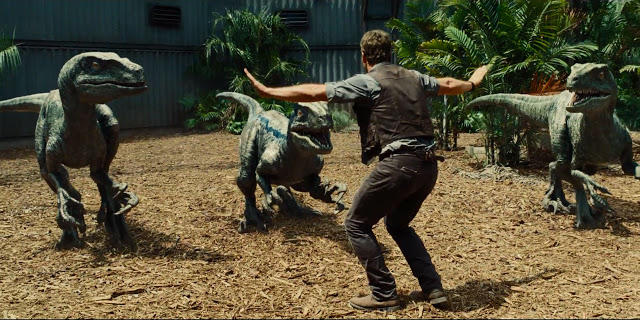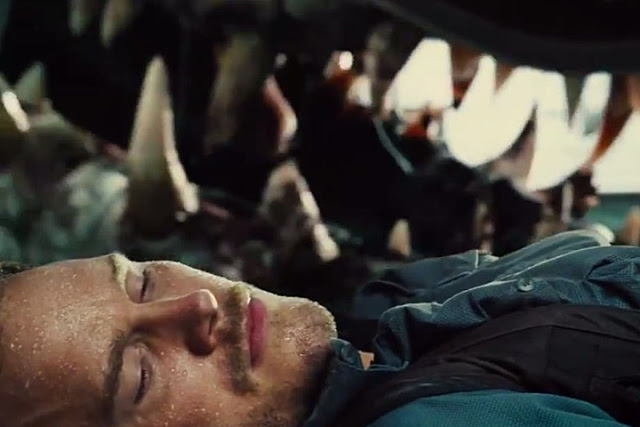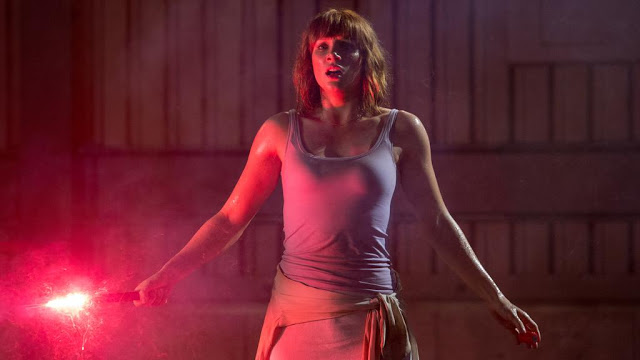A giant looms over the tourists of Jurassic World, a towering figure that casts a long, dark shadow. But it is not a dinosaur. It is, rather, the specter of Steven Spielberg and the lingering greatness of the original Jurassic Park. One score and two years ago, our forefather of blockbuster filmmaking brought forth into multiplexes a new species of movie, a thrilling adventure of CGI-assisted wonder. But as striking and terrifying as certain moments of Jurassic Park were—the sight of water rippling from a faraway impact, the reveal that a reassuring hand is attached to a severed arm, that iconic warning that “objects in mirror are closer than they appear”—what made it truly special was its intimacy. Spielberg makes movies about fantastical creatures and aliens with an inimitably human touch, and in Jurassic Park, he made us care about the people he was terrorizing, from Sam Neill’s wary paleontologist to Richard Attenborough’s hubristic businessman to (most memorably) Jeff Goldblum’s cynical mathematician. It is not hyperbole to suggest that every effects-laden studio production released since 1993 has measured itself, at least in part, against the staggering triumph of Jurassic Park.
Jurassic World, the fourth and not-at-all-bad installment in the dino franchise, never entirely evades the yawning shadow cast by its primogenitor. But this is less a failure of imagination than a consequence of evolution. The world has changed. We now demand increasingly bigger amazements from our summer blockbusters, to the point where it’s difficult to cram emotional texture or narrative depth into a product already bulging with action and spectacle. Or, as one character puts it: “No one’s impressed by a dinosaur anymore.” I beg to differ, and as evidence, I need look no further than Jurassic World. This movie, which was directed by Colin Trevorrow from a screenplay he wrote with three others, may lack certain filmmaking fundamentals—plotting, character development, halfway-decent dialogue—but it is damn impressive.
It is also allegorical, if only faintly. Despite three films’ worth of destruction and property damage (not to mention a considerable body count), we apparently have not yet learned our lesson about the perils of meddling with nature. This time around, the park’s arrogant scientists—including Dr. Henry Wu, the lone returning character from the first film and again played by B.D. Wong, bringing with him a sheen of intelligence and a flicker of mischievousness—have dabbled in genetic experimentation, creating a formidable hybrid dinosaur called the Indominus Rex. When Jurassic World opens, the Indominus is confined in her paddock. She will not remain there for long.
First, though, we must meet the fodder characters. Claire Dearing (a spirited Bryce Dallas Howard, wearing high heels and a red bob) is the manager of the titular theme park, which has shrugged off that earlier unpleasantness and is now a thriving tourist attraction. But business is slowing, and Claire is fretting about a meeting with her boss, Simon Masrani (Irrfan Khan, an obvious stand-in for Attenborough’s John Hammond), who is hoping that unveiling the Indominus will boost the park’s flagging attendance. She is also supposed to be looking after her two nephews, 16-year-old Zach (Nick Robinson) and 11-year-old Gray (Ty Simpkins, the cute kid from Iron Man 3), but she neglects them due to work.
Of course, after spending a handful of minutes with these two, one wonders if Claire’s failure of supervision is less bad babysitting than good judgment. Zach and Gray are the kind of cardboard characters that populate second-rate action movies. They possess just enough dimension to distinguish them from the hordes of anonymous tourists—Zach likes the ladies and thinks the park is boring, Gray is bookish and a dino enthusiast—but their primary function is to be potential victims in need of rescuing. Worse, their purported brotherly rapport—they start off hostile but grow to treat one another with grudging respect—rings hopelessly false. The brothers’ friction and ultimate bonding inevitably and unfavorably recalls Lex and Tim, the plucky sibling duo who outfoxed a pack of velociraptors in a darkened kitchen all those years ago. Jurassic Park made us squirm in fear for Lex and Tim; in Jurassic World, Zach and Gray make you root for the dinosaurs.
Thankfully, the adults get some alone time when Claire recruits Owen Grady (Chris Pratt), a trainer of raptors. Yes, raptors—Grady has used his renowned dinosaur-whispering skills to turn the untamable birdlike beasts into an order-following, pack-hunting machine. They remain caged, however, for most of Jurassic World‘s first half. Instead, Grady travels to the park at Claire’s behest to investigate the Indominus, which promptly stages a diversion and escapes her enclosure. As Robert Muldoon might say: clever girl.
From that point, you pretty much know what to expect: boisterous, CGI-enhanced action sequences alternating with obligatory scenes of exposition and character-building. It is hardly surprising, if slightly dispiriting, that Jurassic World is considerably more comfortable with the former. But what is gratifying about this movie is its demonstration that blockbuster action can be smart and spectacular at the same time. Trevorrow’s set pieces are certainly loud and large, but they are also lithe and fluid, with clear sight lines, coherent choreography, and a feeling of real weight. In one sequence, Grady hides underneath a pickup truck as the Indominus lumbers after him, and the camera cleverly stays with his perspective, revealing only a fraction of the predator’s massive body. In another, Zach and Gray find themselves trapped within one of the park’s “gyrospheres”—a sort of motorized, fiberglass-cased bubble—that the Indominus picks up and attempts to pierce with its teeth, and you feel their panic as their world literally turns upside-down.
And even if Jurassic World‘s humans don’t measure up to its dinosaurs, there are still moments of surprising tenderness amid the clutter and cacophony. At one point, Grady and Claire come upon a field of mortally wounded herbivores, and Trevorrow wisely drops the dialogue and lets Pratt and Howard express the sadness of the encounter. And later, Grady exchanges a long, curious look with one of his raptors, a silent conversation swirling with eddies of wariness, affection, and regret. In these scenes, Jurassic World audaciously strips away the relentless carnage of the enterprise to reveal the humanity percolating underneath.
For the most part, though, we are treated to spry, stimulating sequences of dino-on-dino crime (not to mention the occasional casualty of a random tourist). These incidents are enviable in their variety; the combatants include not only the Indominus and the raptors, but also winged pterodactyls, a good old-fashioned tyrannosaurus, and a hulking aquatic beast that makes the Loch Ness Monster look like a dolphin. Yet as skillful as Trevorrow may be in executing these battles—his savvy understanding of size and scale mimics Gareth Edwards’s achievement in last year’s Godzilla, while his invisible fusion of practical and computerized effects recalls Peter Jackson’s underrated King Kong remake—they are lacking in true magic or wonder. Jurassic World is a very well-made film—Trevorrow, who amazingly landed this gig despite having only directed one prior movie (the charming indie Safety Not Guaranteed), has real chops—but it is more impressive than astonishing. (The cheated feeling of forking over extra cash for yet another perfunctory 3-D conversion doesn’t help.)
Perhaps I would feel differently if I were not so disinterested in the characters. To be fair, their vacuity is not the actors’ fault. Pratt doesn’t stand out here the way he did in Guardians of the Galaxy (he also adopts a shaky Southern accent for no apparent reason), but he’s clearly comfortable as a new-age Han Solo, while Howard is a vibrant and charismatic screen presence. (She also systematically removes various articles of clothing throughout the film, a pattern that some viewers will deem tasteless and others will find appealing—not that I have anyone in mind.) But despite the performers’ best efforts, Grady and Claire never feel like real people (the romance that develops between them is utterly laughable), and Zach and Gray are much, much worse. Even the supporting cast—typically the area where rigid franchise fare makes room for outlandish and memorable performances—fails to make much of an impression. Vincent D’Onofrio has an unfortunate role as a military contractor who envisions weaponizing Grady’s raptors (the allegory here is too ham-fisted to be intriguing), while a pair of office drones (played by New Girl‘s Jake Johnson and Orange Is the New Black‘s Lauren Lapkus) might as well have adorned their desks with placards reading, “Strained Comic Relief.”
None of this makes Jurassic World any less entertaining or less expertly designed. It is important to acknowledge its achievements, even when also recognizing its faults. But as enjoyable as this movie can be, it is fighting a doomed battle, because no matter how quickly it moves, it cannot evade unflattering comparisons to Spielberg’s first film. (That composer Michael Giacchino liberally borrows from John Williams’ classic score only reinforces this sensation, as does a character wearing a rumpled T-shirt that sports the original’s logo.) As a result, watching Jurassic World engenders the powerful desire to immediately return home, unearth your VCR from your closet, and pop in your now-musty videotape of Spielberg’s original. Jurassic Park came out more than two decades ago. But movies in the rearview mirror are closer than they appear.
Jeremy Beck is the editor-in-chief of MovieManifesto. He watches more movies and television than he probably should.



